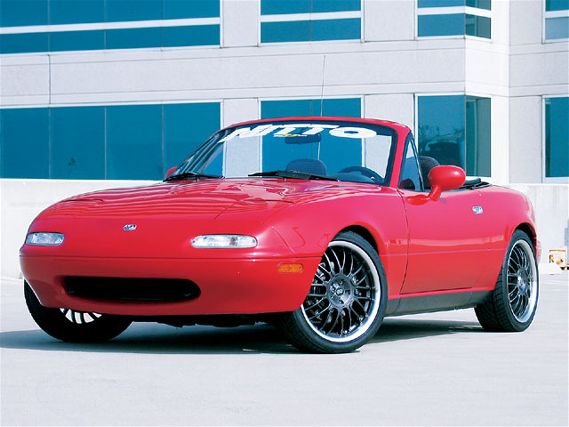 | 1994 Mazda Miata Project Possibilities - Dyno Cell
| 1994 Mazda Miata Project Possibilities - Dyno Cell The Mazda Miata is one of the more intriguing used performance car bargains on the road today. The Miata delivers wind-in-your face thrills, thanks to its drop-top configuration, rear-wheel drive, prices starting in the $1,000-to-$1,500 range and a myriad of performance options once you get in.
The Mazda enjoys an excellent aftermarket following. The usual bolt-ons, as well as rods, pistons and complete turbo conversion kits are available for your tinkering. The SCCA even has a spec road racing series just for the Miata, and we wouldn't be surprised to see some of these little monsters on the drift scene soon.
We wheeled a 1994 1.8-liter Miata into the Dyno Cell for a quick round of bolt-ons. One of the less-heralded, but important, qualities of the Miata is how accessible everything is under the hood. It's a very easy car to work on. On tap for this session is Jackson Racing's "triple threat"-a cat-back exhaust, header and intake system. Prior to baseline dyno testing the Miata, the engine was checked to ensure it was in good health and a set of Jackson Racing plug wires were added in place of the decrepit stockers.
On the rollers, the Miata belted out 100.2 whp in stock trim. First to bat was the Jackson Racing cat-back exhaust system. The system features stainless-steel materials, a rolled polished tip and a center resonator that delivers a healthy tone without damage to inner ear components. Back on the dyno, the Mazda put down 104.0, a 3.8-horse gain in peak power.
Next was the Jackson Racing header. It too, is constructed of stainless steel and features CNC-fabricated flanges and TIG welding throughout. With the dyno rolling, the Miata proved to be stingy as the header gained only 1.9-whp peak power.
Undaunted, we swapped on the Jackson Racing intake system. The system features an ABS plastic duct system that directs cool air to the flat, replacement-style, high-flow filter. The intake pushed peak output to 110.4 whp. The triple threat increased power by 12.2 whp at 6300 and delivered sizable gains (minimum 7 whp) from 4900 rpm to the end of the pull, right in the heart of the Mazda's power curve. A 10.2-horse gain at peak may seem small but remember where we started-the mods netted more than a 10-percent horsepower gain.
The Miata is a balanced performer, and to optimize on-road performance, a set of Tokico Illumina five-way adjustable gas shocks, Tokico lowering coils and Jackson Racing anti-roll bars were added to the mix. Also part of the suspension makeover are 17x7 Enkei MM2 wheels wrapped by Nitto Neo-Gen rubber. Stopping power has been enhanced with a Flyin' Miata brake upgrade package that features Flyin' Miata slotted rotors, Wilwood four-piston calipers and heavy-duty lines up front. The rear is adorned with Flyin' Miata slotted rotors.
The result of these quick and easy mods is a supremely driveable package that delivers a mean one-two punch: a 10-percent jump in power and suspension mods designed to unleash the g-forces.
CAR Mazda Miata MX5 ENGINE 1990-1993 1.6-Liter 1994-up 1.8-Liter DOHC Four Cylinder YEARS OF PRODUCTION 1990-Present STREET PRICES $1,500 and up MOD-ABILITY 8.5 out of 10